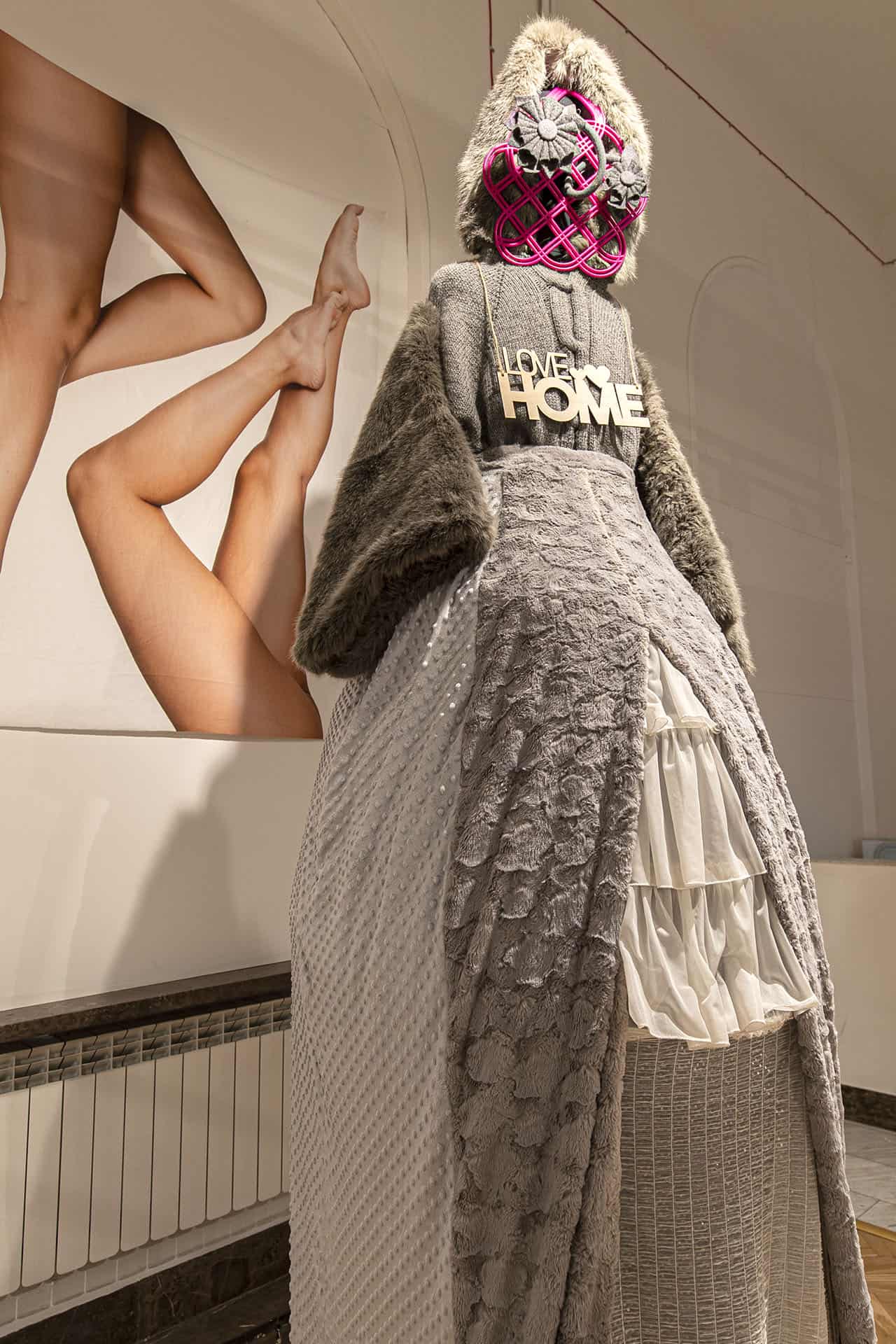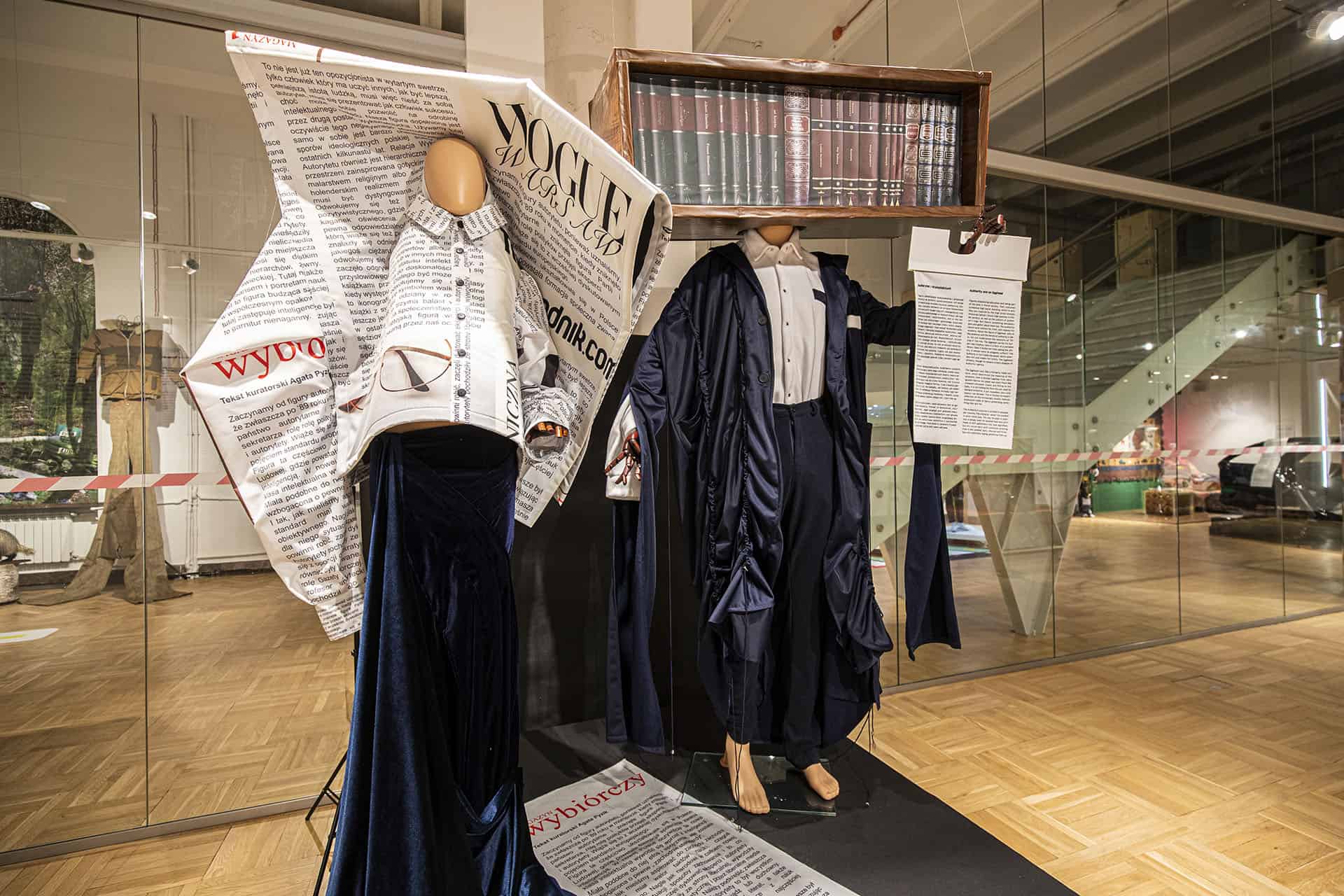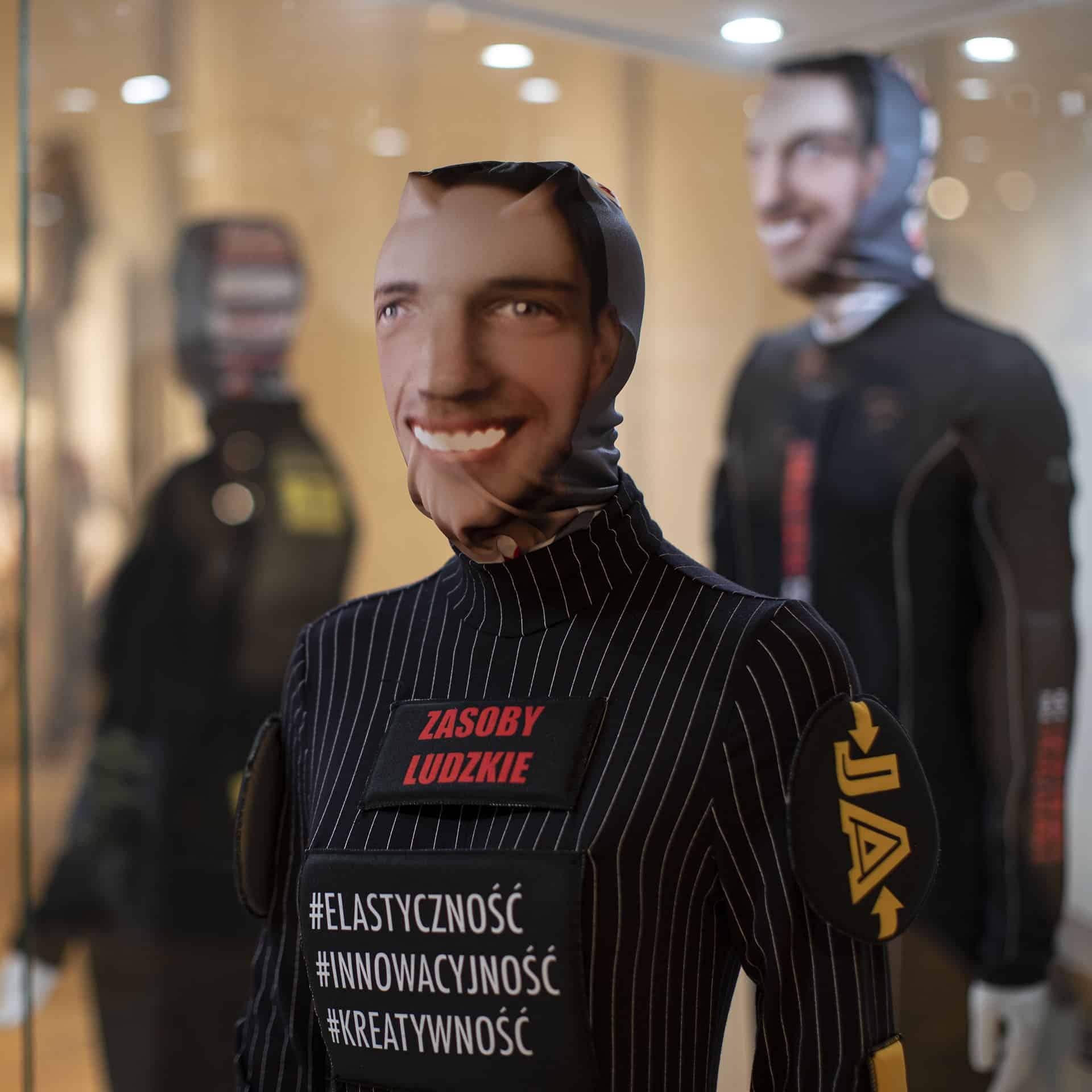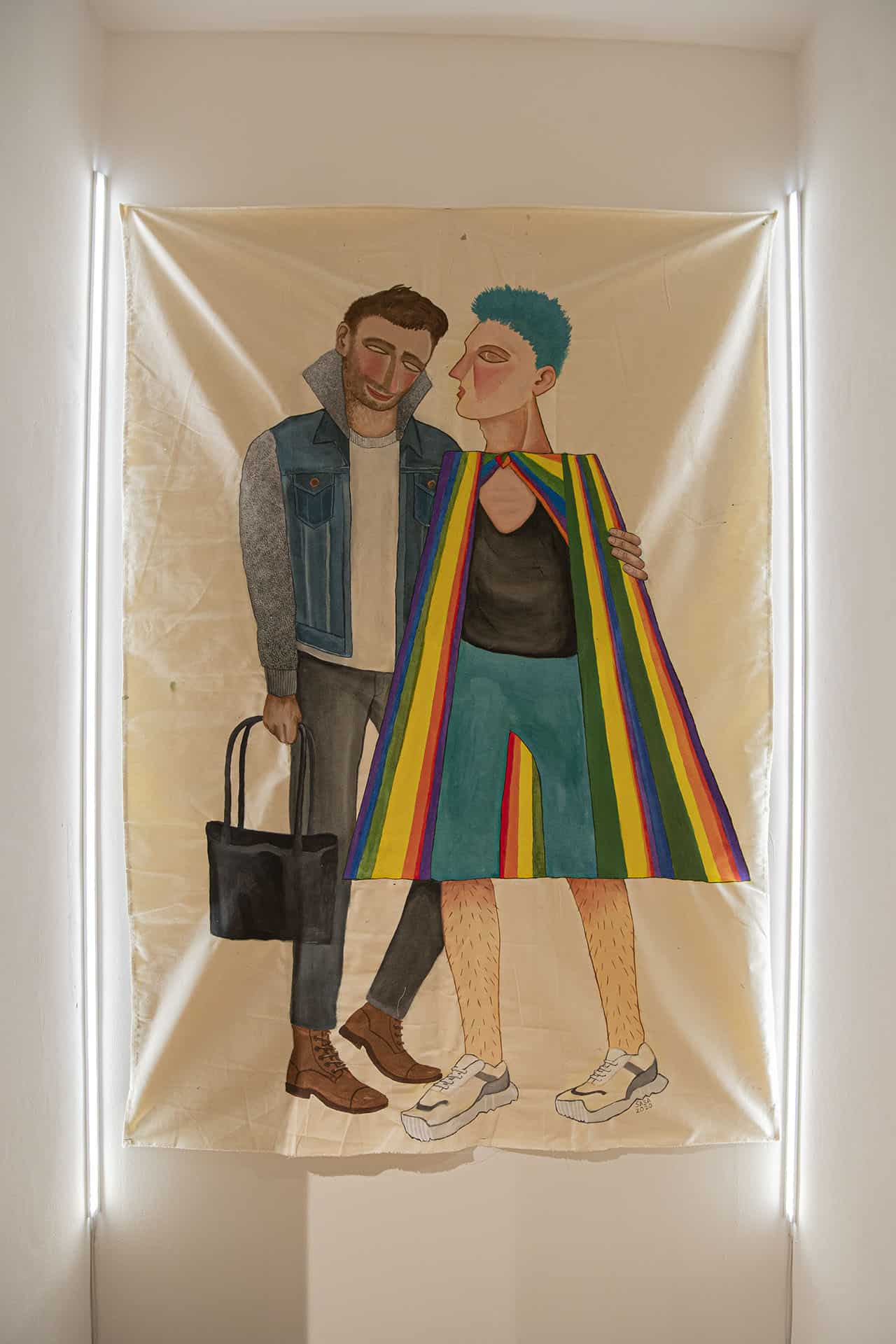“Diversequality” exhibition, the National Ethnographic Museum in Warsaw, photo Przemysław Walczak
Michalina Sablik: The exhibition Diversequality (Równorodność) is currently being held at the National Ethnographic Museum as a part of larger series titled Iconic Things. What is this project? What kinds of exhibitions have already been organized within its framework?
Anna Grunwald: It is a three-year project of the museum launched in 2018. It sprung from our interest in popular culture, our research into the contemporary culture and noticing an important issue of nostalgia. Together with Bartek Robotycki and Ilona Sikorska, we searched for topics that would increase audience’s engagement by referencing the memories from their childhood and youth, as well as other, more universal themes. We want to consistently change the image of the museum, take a departure from its general perception, as an overbearingly traditional institution solely focused on the folklore. Our inspiration came from pop-culture museums located in various European countries maintaining their ethnographic focus while remaining open to other cultures, cross-cultural phenomenon, popular culture, issues of minorities and migration. We were interested in the culture as such. There were couple of project components: research, engagement and/or debate on the subjects, such as: fashion, cuisine, and motoring. Scientific articles were also published. So far, the most popular exhibitions were Disco Relax and The Many Incarnations of Deer dedicated to disco polo music, migration of motifs, as well as the aesthetics of camp and kitsch. A huge media buzz was generated at the time about the culture of disco polo, so we approached it from the analytical and ethnographic angle, in attempt to tell the story about this cultural phenomenon. In this project, we intend to feel the pulse of contemporaneity, raise emotions, as well as, educate and encourage debate.
M.S.: Where did the idea come from to invite Tomasz Armada, a fashion designer, to open the exhibition at the National Ethnographic Museum?
A.G.: Michał Piernikowski, the director of Łódź Design Festival, invited Tomasz Armada to the debate “Let’s Talk About Taste”, which we organized a year ago at the museum in an answer to the observed fact that numerous modern conflicts revolve around taste. We wanted to understand what falls under the category of good and bad taste, who decides that, and how you can validate “bad taste” by presenting/playing disco polo at the museum, for instance. As the authors of the project, we were mesmerized by Tomasz’s sensitivity about what is generally considered low-brow and in bad taste, by his keen interest in the subject of Polish identity and familiarity, as well as, an affirmative and empathetic attitude towards the national traits of the Poles. So, we decided to invite him to open his next exhibition at our museum.

“Diversequality” exhibition, the National Ethnographic Museum in Warsaw, photo Przemysław Walczak
M.S.: The collection presented at the National Ethnographic Museum is not your first project which nods towards contemporary folklore, low culture, quaint backward Poland. One of your early renown fashion collections was inspired by the Polish wedding. Where does this fascination come from?
Tomasz Armada: It comes from the environment where I was growing up, a small town where the only cultural centres were the Catholic church and a library, which organized events affirming the nationalist spirit. The only access to culture I had was to the so called low (or popular) culture, including disco polo. I come from Świętokrzyskie region that maintains deeply elaborate wedding traditions. I have always found them both fascinating and inspiring. Even though the vast majority of the Polish society are from peasant descent yet they often pretend otherwise. This tendency is embedded firmly in our identity. This is where this fascination with folklore and peasantry comes from.
M.S.: You affirm these subjects as opposed to being ashamed of them.
T.A.: Initially, I was deeply ashamed of my origin, especially after I joined the scene of aspiring fashion designers. I used to pretend to be someone else, trying to create these avant-garde minimalist collections, I focused on the formal aspects and completely overlooked the philosophical and social implications of clothing and image.
References to the sartorial expressions of patriotism appeared only in my graduate collection that combined this phenomenon with Sarmatian attire of the Polish nobility from the 17th century. Afterwards, I started exploring meaning, history, and tradition of clothing.
M.S.: Your exhibition adopts the traditional language of the 19th century ethnography and anthropology, which you proceed to mock, distort and flout. What qualities of the ethnographic language captured your attention?
T.A.: I enjoyed visiting the ethnographic and open-air museums in Poland and Ukraine. Sometimes I also attended exhibitions of the amateur artists filled with conspiracy theories, philosophy of history, and eerie artifacts. The visual language of these places appealed to me and thus inspired the creation of all these “scarecrows” for the exhibition at hand. Using the tools of contemporary art, I assembled the exhibition featuring numerous installations and totems, verging on fashion and stage design. According to Ewa Klekot, the presented figures bear close resemblance to the traditional nativity scene.

“Diversequality” exhibition, the National Ethnographic Museum in Warsaw, photo Przemysław Walczak
M.S.: Entering the exhibition, I expected to see a fashion collection sensu stricto. Instead, you created something more. There is an abundance of installations, videos, stage design elements, as well as other artists’ works. Why did you decide to expand the fashion show’s formula? Certainly, it is not the type of collection that could be unveiled on the runway.
T.A.: I resorted to the language of visual arts and theatre, with which I am well familiar, because some of the “types” we came up with for the sake of this exhibition could not be translated into the sartorial language. The ideas for various kinds of assemblages and stage designs emerged, I invited other artists to collaborate with me on the exhibition that came to incorporate painting, performance, video and audio broadcast. For instance, I was unable to imagine the outfit for a gay couple. I was simply afraid of succumbing to the cliché or naïve imitation.
M.S.: What artists did you work with and why?
T.A.: I worked with Sasa Lubińska when she was a member of the former collective fashion house Limanka. She painted the portrait of a gay couple alluding to Zofia Stryjeńska’s painting and made the video about the “alternative” bunch. Taras Gembik created the piece for the “Ukrainian” pit stop. For him, I designed the outfit in “ethnic” style referring to the Volhynian folklore. As part of his performance, he stripped off his clothes along with the national and gender identity. Whereas the group Siksa recorded the audio broadcast titled “Odmieniec” (“Misfit”).
M.S.: Let us talk a bit more about these social types you have mentioned. The exhibition features thirteen avatars that, in your opinion, best represent different social classes in Poland, such as: the Europoles, intelligentsia, and beneficiaries of the +500 programme. Are these types based on your own observations or did you consult any anthropologists and contemporary culture experts?
T.A.: Agata Pyzik, a curator, writer and author of the book Poor But Sexy: Culture Clashes in Europe East and West, alongside curators of the National Ethnographic Museum who played a significant role in the process. We came up with the types together, frequently drawing on the antithesis.For example, when we created an image of a housewife, we needed to create one of a real man. Our project was also a response to the dire state of the press and media that insist on categorizing people, entrenched in their tribal mentality, addressing very specific “bubbles” of audiences. The idea was to confront the Warsaw-based audience living in its highbrow liberal bubble with the fact that their way of thinking about “others” (people from the countryside, other social classes, etc.) is often unfair and detrimental.
A.G.: The collaboration with Agata Pyzik helped Tomek gain a better grasp of his intuitive insight into the Polish society and place it in the theoretic context. We decided to define them as Polish common folks. Nevertheless, we were always careful to avoid stereotypes, ridicule, malice, and harsh criticism. We wanted to approach these types with great sensitivity since in fact every single one of us met these figures as members of our families and/or friend groups. Therefore, it was important for us to build this platform for re-evaluation, analysis and discussion, which we lack in contemporary polarized society. We also did not shun any subjects, which are now present in the society, such as: LGBT community in Poland or immigrants. The National Ethnographic Museum is often perceived as an archaic institution, so we wanted to break away with convention, delve into contemporary issues, exhibit the Polish types of 2020 while preserving the cognitive authenticity of an ethnographer that tells the story of reality, takes notice of the marginal, ignored, neglected social groups.

“Diversequality” exhibition, the National Ethnographic Museum in Warsaw, photo Przemysław Walczak
M.S.: What is your understanding of the eponymous collection? Would you say you are certain that the collection will acquire the historic value?
A.G.: Museum is the reservoir of artworks, old objects, testaments to history, and the by-gone days. Tomek’s collection will also be included in the museum’s own collection. For this reason, we wanted it to closely represent today’s reality.
T.A.: As we were preparing this exhibition, museum curators, researchers and I would often discuss the role of an ethnographer who has this vast knowledge and decides which material elements of culture will be preserved and which will perish. I believe our conjecture will have the historic value only if the scholarly survey accompanies both the objects and the collection.
A.G.: We are very curious about the audience’s response to the collection in dozens of years in the future, when it will be taken out of storage. Will the viewers understand our point of view, humour, and light-hearted distance? Will they understand the process behind assembling such an exhibition, at all?
M.S.: You take the reality with a pinch of salt, poke fun at it, queer it up, so to speak. What role does parody and humour play in your practice? Were you apprehensive about the potentially serious response of viewers, some of whom might take umbrage at the presentation?
A.G.: Unfortunately, we cannot be held accountable for someone else’s feelings about the exhibition. Anything can hurt anyone’s feelings, theoretically. It certainly was not our intention to do so.
T.A.: I suppose I am slightly out of touch with the things that might ruffle someone’s feathers. During the Pomada Festival in Warsaw, I used a disco polo track as background music for my performance, and some theatre critics left the audience irate. In my practice, I strive to intertwine various orders, blur the distinction between high and low culture, toy with the gravitas attributed to patriotic themes. I approach and subvert the symbols of tradition and identity with humour and distance, but not without respect. It is all very important to me, and I have the right to celebrate it as I see fit, as well as subject it to a dose of criticism.
M.S.: I find the fact of mixing orders incredibly interesting. The exhibition Diversequality elevates the status of everyday objects into museum artifacts. Meanwhile, as a fashion designer you elevate the status of second-hand clothes into high-fashion products.
T.A.: I try to burst the restricting bubbles and art disciplines, operating in-between the world of fashion, contemporary art, and theatre which are poles apart from one another, contrary to what one might think. The fact that Małgorzata Godlewska wears my outfits compels the audience immersed in high culture to watch Top Model. On the other hand, I bombard the fashion-lifestyle-mainstream circles with content related to sophisticated and ambitious contemporary art on all of my social media channels.

“Diversequality” exhibition, the National Ethnographic Museum in Warsaw, photo Przemysław Walczak
M.S.: I wanted to ask you about your collaboration with the Godlewska sister, a controversial YouTuber and a frequent subject of ridicule. To celebrate the recent Independence Day, she released her version of the Polish national anthem accompanied by bagpipes. In the background, we see a rainbow flag, references to women’s protests. Godlewska herself is wearing an outfit by Tomek Armada. How would you interpret that?
A.D.: What is interesting the bagpipes were borrowed from the educational section of the collection owned by the National Ethnographic Museum. However, the project itself was shrouded in mystery!
T.A.: She has always been a cultural phenomenon to me. At some point, she started creating critical pieces on her own accord, for example singing Christmas carols to the heads of bishops falling down like snowflakes. Do you remember her version of Rota [patriotic song] where she mentioned that the author was a lesbian in the introduction? In my opinion, it is the most fascinating example of contemporary critical art that has a bigger reach than all cultural institutions combined. She records video-performances referring to current events. I was a fan of her creative and uncompromising approach. The author herself was mocked on the internet. One day, she asked me if I could lend her an outfit for the party organized by Pudelek [Polish gossip site]. I agreed and went with her. Małgorzata is an intelligent, warm, and lovely person. She is one of the most open and good-natured people I have ever met at the cultural scene.
A.G.: I agree that, she is the nicest person ever! It is very important to abolish stereotypes, juxtapose two different worlds against one another. Various products of culture are worth poring over. People often boost their own self-esteem, put on airs, denounce the things viewed as crude and trashy within their bubble. Then all of the sudden embodiments of kitsch become the objects of desire, low transformed into high. All cultural phenomena are worth paying attention to and to be approached without any biases. If they do revolt us for some reason; perhaps, we should try and understand why. We are walking amalgamations of our origin, environment, experiences, prejudice, and stereotypes. The so-called intellectuals sneer at the +500 beneficiaries, millennials mock boomers, people from the cities dismiss those living in the countryside, and so on.
M.S.: We enjoy putting people into boxes, pigeonhole and label. And that is what this exhibit is all about, is it not? What meaning does its title Diversequality hold to you?
A.G.: We cared neither for an easy reception of an exhibition nor for providing obvious solutions. Perhaps it would be easier to just make a pompous exhibition about the merit of tolerance and openness. Its illustrative form, put forward by Tomek, is a metaphor, jocular, and sincere presentation offers the opportunity for a debate in lieu of ideological dispute. It allows us to take a more tender and delicate look at our own society.
T.A.: The title was originally just a random typo turned a perfect neologism encapsulating the concept of our exhibition and it is not the word “tolerance” whose omnipresence rendered it dingy and tired and cliched. The title blends two significant words together: “diversity” and “equality”. Our intention was to stage the exhibition that would open up a space for dialogue for people who do not usually have a chance to meet, talk and clash just because they stay in their own bubbles.

“Diversequality” exhibition, the National Ethnographic Museum in Warsaw, photo Przemysław Walczak








